Location:
PMKI > Project
Management History > The Development of Modern
PM.
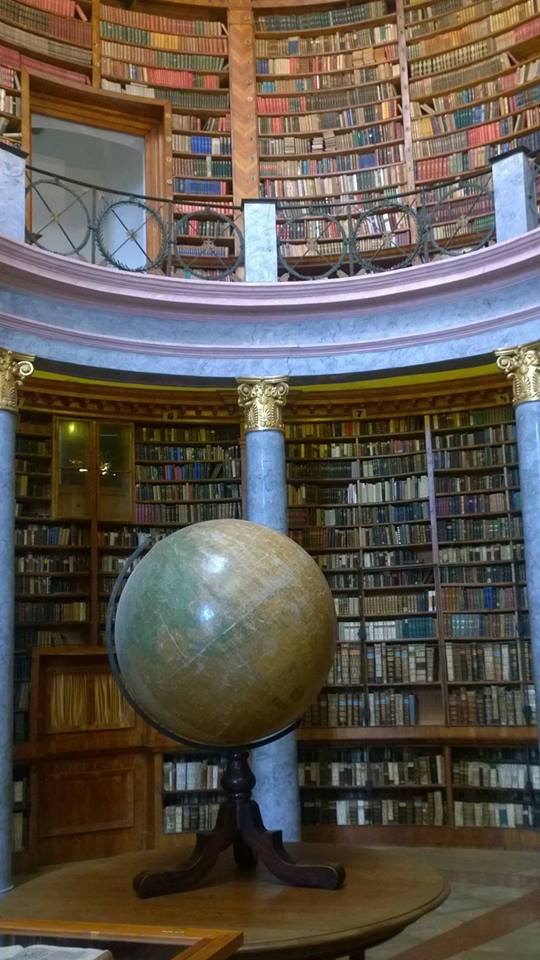

- Origins, and trends in, modern
project management
- The development of project
management credentials
- The evolution of construction
management.
- Transport Projects
- Roads
- Canal
projects
- Railway
projects
- Building Projects
- The development
of Construction Management
- Egyptian,
Greek & Roman projects
- Dock and
Harbor projects
- The evolution of
a suburb - South Melbourne
Other related sections of the PMKI:
- The history of project
controls
- Current project management
practice and the PMBOK® Guide
- The evolution of ancillary
and supporting concepts
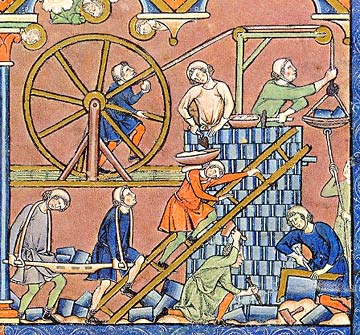
Projects in one form or another have been undertaken for millennia:
- The ancient Egyptians constructed pyramids some 4500
years ago
- Sun Tzu wrote about planning and strategy 2500 years ago
(every battle is a project to be first won;
then fought)
- Numerous transcontinental railways were constructed
during
the 19th century, and
- Buildings of different sizes and complexity have been
erected for
as long as mankind has occupied permanent
settlements.
Click down for the origins of construction management.
However, it was only in the latter part of the 20th century people started to talk about ‘project management’. There is an important distinction to be drawn between projects: ‘a temporary endeavor to create a unique product, service or result’ and ‘modern project management’ as it is embodied in the various project management associations around the world. The concept of ‘modern project management’ is a creation of these associations starting in the 1960s. During the next 50 years they developed a generally consistent view of the processes involved in ‘project management’, encoded these views into ‘Bodies of Knowledge’ (BoKs), described competent behaviors and certified knowledgeable and/or competent ‘Project Managers’ (click down for the history of PM credentials). Whilst the underlying philosophies used by modern project management are much older, the key change in this period was the melding of processes, techniques, and management philosophies into a body of knowledge (BoK), and the effective dissemination of the ideas of modern project management into the wider community.
The central theme running through the various BoKs was that project management is an integrative process that has at its core, the balancing of the ‘iron triangle’ of time, cost and quality, to produce a predefined output. All three facets must be present for a management process to be considered project management. However, as the 21st century progresses, this holistic view of the profession is starting to devolve into a series of discrete sub-disciplines using quite different methodologies and approaches; the consequences of this emerging trend remain to be seen.
During the 1960s and 70s, the catalyst for the spread of
discussions on project management and the formation of
associations to support these new ideas appears to have
been the spread of scheduling, and more importantly
professional schedulers. Arguably, the schedulers need for
a forum to discuss and develop their new discipline led
directly to the formation of the various project
management associations. Once founded, it was (and still
is) the various project management associations that led
the development of a defined and documented ‘project
management body of knowledge’. Only after the body of
knowledge was formulated, did it become possible to:
- Define project management competencies (see:
Competencies & Interpersonal Skills),
and
- Formally examine project management knowledge
(see: PM
Training & Qualifications).
The major history papers on this site are:
- The Origins of Modern Project Management
(below)
- The Origins of Modern Management
(below)
- and three papers on project controls that can be
downloaded from the links:
- A
Brief History of Scheduling.
- The
Origins and History of Cost Engineering
- The
Origins and History of Earned Value Management.
Specific aspects of PM history such as the origins of CPM or Agile have their own pages or sections, these are detailed in the Section Index.
PP: Project Management - A Historical Timeline.

The objective of this paper is to put the development of
management, and project management capabilities into a
wider historical perspective. This is done by associating
some of the significant events in history with the
advances in management thinking documented in our papers,
together with a brief selection of important engineering
and other achievements.
Each of our history papers tends to be topic specific, for example focused on advances in cost engineering or the creation of bar charts. This paper juxtaposes the documented advances in each of the separate papers, and places them in the context of general history. References are provided to the more detailed topic-specific papers.
This paper is regularly updated as we find or publish new
information,
(Download the original Jan. 2023 PMWJ
version of the paper).
PP: The Origins of Modern Management. This paper discusses the ways in which management theories evolved from the beginning of the 18th century through to the 21st century and how these developments influenced the creation of 'modern project management'.
PP: The Origins of
Modern Project Management. This paper
discusses the ways in which management and technological
innovations of the 20th century interacted to encourage
the establishment of project management tools
(particularly scheduling), leading to the formation of PM
institutes, which in turn created the profession of modern
project management. Assuming the central hypothesis in
this paper holds true, that: the spread of scheduling was
the genesis of ‘modern project management’ ; then the 50th
anniversary of the start of the process that created
‘modern project management’ was the 7th May 2007.
Includes brief outlines the foundation of IPMA, PMI (see
also
Founding PMI), and AIPM.
Art: The Evolution of Project Management This paper is an attempt to classify the various phases in the development of the practice of project management based on the way the project manager was appointed and the control tools used to manage the project. As a starting point, we have adopted Prof. Peter Morris’ distinction between the management of projects and project management. Then the major phases of development of project management is driven by fundamental changes in the way the person, or people, responsible for managing the project were appointed with these phases being subdivided when the tools used to support the management of the project changed. The original version of this paper was published in November 2022 in the PM World Journal (download the published article).
Blg:
Defining Traditional Project Management.
Before the start of the 21st century there was only one
basic approach to project management outlined in the PMBOK®
Guide and many other reference sources. The Agile
manifesto changed this forever. This post looks at
defining the traditional way of managing projects to
provide a basis for comparing other emerging trends and
ideas.
Click through to the
history of Agile and Waterfall.
Art: Incentive Payment Schemes. A brief outline of personal incentive payments from 13th century piece-rates to profit sharing.
PP: Trends In Modern Project Management - Past Present & Future. The profession of ‘project management’ is largely a creation of the ‘project management associations’ starting in the 1960. During the first 40+ years, they developed a generally consistent view of the processes involved in ‘modern project management’, encoded these views into ‘Bodies of Knowledge’ (BoKs), describe competent behaviours and certified knowledgeable and/or competent ‘Project Managers’. This paper reviews the roots of project management, briefly looks at the evolution of the discipline into a profession and then attempt to predict where success for project management practitioners will lay in the future as the practice of managing projects devolves into a series of very different approaches.View the PowerPoint presentation.
Click through to out page focused on modern corporate management.
Click through to out page focused on modern project management.
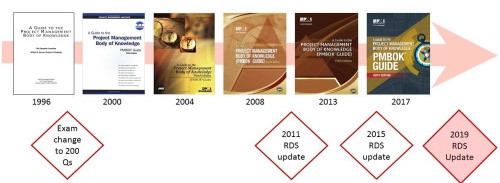
The original Project Management Body of Knowledge (1987) is now available as a PDF file. Converted to PDF by Max Wideman, it's free on request. To see more click through to: http://www.maxwideman.com/PMBOK1987reborn/intro.htm. This document:
The 6th edition of the PMBOK® Guide was the last version based on the original concept. The 7th edition,published in 2021 shifted the focus from processes to business outcomes.
Blg: The PMP® Examination is 30 years old. A brief history of the linked development of PMI's PMP examination and the PMBOK® Guide.
Blg: The PMBOK® Guide 6th Edition and its consequences. The evolution of the PMBOK and the PMP exam through to the publication of the 6th Edition in Q3 2017.
Click through for our page focused on current project management credentials.
The evolution of construction and engineering management
in the 18th and 19th centuries, was a major influence on
the evolution or project controls, including scheduling
and cost engineering. For more on the history of these
disciplines see: The
History of Project Controls.This section looks
at the history of Transport Projects and general Building and Engineering Projects.
This section focuses on the built infrastructure used for
transportation rather than the movable engineering
(wagons, boats, trains, etc.), and is in three parts:
- Road building
- Canal building
- Railway building.
The way the management of these projects evolved over the centuries was a major contributor to the development of project management. From the mid-18th century on, the construction of canals, then railways posed significant logistical challenges with significant time and cost constraints on the people managing the development.
 Road
building (or the lack thereof) was the driver for the
development of canals and then railways. Despite having an
incredibly long history in the UK, after the Romans any
road building was localized and of low quality. Parishes
were responsible for most of the roads in their area and
rarely had the funds and inclination to look after through
routes. The introduction of paid Turnpikes originated in
the 17th century because local parishes were unwilling or
unable to invest in roads.
Road
building (or the lack thereof) was the driver for the
development of canals and then railways. Despite having an
incredibly long history in the UK, after the Romans any
road building was localized and of low quality. Parishes
were responsible for most of the roads in their area and
rarely had the funds and inclination to look after through
routes. The introduction of paid Turnpikes originated in
the 17th century because local parishes were unwilling or
unable to invest in roads.
The finances of turnpike trusts were distinctive because they levied tolls on road users and issued bonds mortgaged on these tolls. Turnpikes reduced travel time for passengers, but were not located to suite the emerging industries.
The widespread adoption of motor vehicles in the early 20th century was the trigger for a change in priority from rail to road construction.
Blg: Built to last. This post looks at the durability of Roman road construction and marine construction techniques.
Blg: Adaptive Processes are Not New. This post looks at the way Roman engineers adapted their standard road construction process to the environment they were building in, but still achieved a highly durable result.
DP: The Turnpike Roads of England and Wales. An academic paper documenting the development of Turnpike roads in the UK from the 17th century on. These provided substantial economic benefits, most directly through improvements in transportation and reduction in travel times.
Art: The First Canals This article expands on the paper above to look at the early development of canals in Europe and Asia from 4000 BCE through to the European medieval canal revival between the 12th and 16th centuries.
Art: Early Canals, The Evolution of the Technology Canals have been excavated for drainage and irrigation for thousands of years and once built, the larger of the canals were undoubtedly used for trade. However, for several thousand years canals were restricted to areas where the land was relatively flat. This article looks at the development of the technologies that allowed canals to traverse hills and valleys.
PP: Early Canal Projects in the UK Until the introduction of efficient steam-powered railways, canals were the driving force behind the industrial revolution in Britain. This paper looks at the development of canals in the UK from Roman times through to the start of the 'canal mania' in the 1790s, and seek to identify where possible the contractual and management processes used in their construction.
DP: Navigable waterways and the economy of England and Wales: 1600-1835. An academic paper by Max Satchell, Cambridge University, detailing the development of river navigations and canals from the perspective of social history.
PP: Cost Overruns on Early Canal & Railway Projects. The difficulties in determining a realistic cost for a new class of project are understandable. But, transport projects in the United Kingdom (UK) predate the industrial revolution by several centuries. This suggests that in addition to the lack of empirical cost information, the problem with the cost estimates identified in The Origins and History of Cost Engineering may have been caused by various combinations of poor governance, questionable ethics, and optimism bias. The same set of issues that continue to plague many modern mega-projects.
One of the world's fastest construction booms was the
building of some 6000 miles (10,000 Km) of railways in the
UK at the start of the Victorian era:
- The first viable steam locomotive was built in
1812
- The first public railway opened in 1821
- The first intercity railway opened in 1830, and
- Some 6000 miles of railway had been built by the
1850s.
These papers offer an insight into the two factors needed for such a major undertaking resources and knowledge. The workforce needed to build the railways came from the canals (discussed below). The abrupt halt in the canal building boom in the 1840s was caused by the opening of the first railways (see Railways below). The skilled workforce that had been working on the navigations simply transferred across to building railways (but kept their designation as navies). The excavation of cuttings, building or embankments and the masonry needed to build bridges is similar in both canal construction and railway construction.

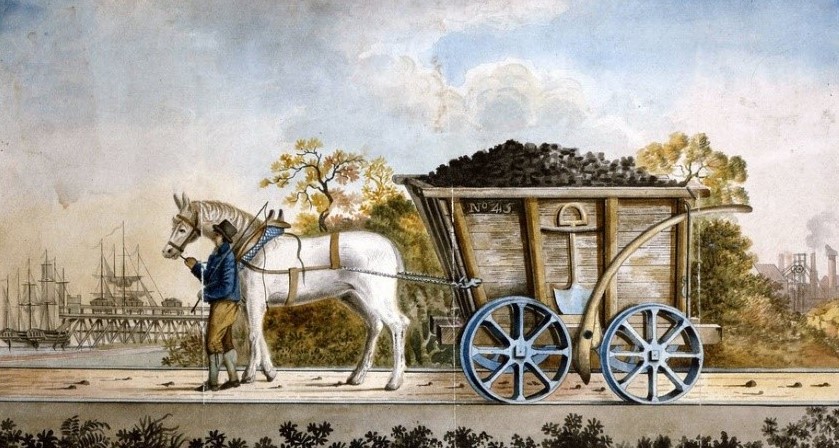 PP: The First Railway
Projects. Transport projects in the United
Kingdom predate the industrial revolution by several
centuries. This paper looks at the building of some of the
earliest railway projects (horse drawn wagonways) to
identify where possible the contractual and management
processes used in their construction and their influence
on the industrial revolution.
PP: The First Railway
Projects. Transport projects in the United
Kingdom predate the industrial revolution by several
centuries. This paper looks at the building of some of the
earliest railway projects (horse drawn wagonways) to
identify where possible the contractual and management
processes used in their construction and their influence
on the industrial revolution.
DP: The Discovery and Excavation of the Willington Waggonway. An academic paper detailing the archeological excavation of the Willington Waggonway, as well as providing more detail on the construction of the early wagonway network.
Art: Myths and Legends: The Origins of Standard Gauge Railways Standard gauge is used by approximately 55% of the railways world-wide. This article looks into the origin of the standard gauge dimension and the series of coincidences that made 1435mm the 'standard' for railway construction.
DP: The development of the railway network in Britain 1825-1911. An academic paper by Leigh Shaw-Taylor and Xuesheng You, Cambridge University, detailing the development of the British railway network during the nineteenth century.
Blg: Where were the first passenger railways built? Most of the early railways were built for the transport of freight, usually coal. Some of these lines did carry passengers as a sideline, but were not built for a combined passenger / freight operation. This post looks at some of the early railways and/or tramways that included passenger operations from a very early stage in their development.
Art: The First Steam Powered Railway in Australia Following the discovery of gold in Victoria in 1849, and the gold rush of 1852/53, the need for an efficient transport link between the port at Sandridge and the city of Melbourne was paramount. The problem was overcome by constructing a privately funded railway that opened in 1854. Other railways soon followed: See the detailed 1864 map of Melbourne by H.L. Cox R.N.
Blg: The Diolkos – The first truly commercial project? Diolkos on the Isthmus of Corinth in Greece, is probably the first purpose-built railway in the world (if you define a railway as a set of tracks that guide wheeled vehicles). This blog takes a close look at this fascinating project constructed in the early part of the 6th century BCE to transport ship across the isthmus from the Gulf of Corinth to the Saronic Gulf and the port of Athens.
PP: Cost Overruns on Early Canal & Railway Projects. The difficulties in determining a realistic cost for a new class of project are understandable. But, transport projects in the United Kingdom (UK) predate the industrial revolution by several centuries. This suggests that in addition to the lack of empirical cost information, the problem with the cost estimates identified in The Origins and History of Cost Engineering may have been caused by various combinations of poor governance, questionable ethics, and optimism bias. The same set of issues that continue to plague many modern mega-projects.
100 Years Later....... The early documentary, in the modern 'story-telling' style, Night Mail shows the development of the rail network after a century of progress between 1830 and 1930: https://youtu.be/KTEZ25sQGmc
This section focuses on the evolution of the
construction industry, and is in four parts:
- The development of Construction
Management
- Egyptian, Greek & Roman projects
- Dock and Harbor projects
- The evolution of a suburb - South
Melbourne.
The development of the construction management in the
19th and 20th centuries was a direct precursor to the
emergence of project management in the 1940s and 50s.
Blg: Incentive contracts are not new. The contract to glaze the Great East Window of York Minster between 1405 and 1408 was a fixed price, incentive contract, with the contractor responsible for the design and installation of the largest medieval stained-glass window in UK. The contract was completed successfully and is still a remarkable work of art.
Blg: Project Management in the 15th Century. The construction of the dome to complete Florence’s new cathedral, by Filippo Brunelleschi, between 1420 and 1436 faced a unique set of challenges both technical and political.
Blg: Construction project management is a very old profession. The construction of Hwaseong Fortress in Korea that was built between 1794 and 1796.
Blg: The evolution of design processes This post briefly looks at the development of orthographic projection and the foundation of the the École Polytechnique in Paris in the late 18th century, which together transitioned engineering design from an art to a mathematical science underpinning the engineering and construction booms of the 19th century.
Blg: The Origins of Military Engineers. Military engineers have been a part of an Army for millennia. But until relatively recent times, the engineer was an individual who directed the work of troops, or civilian contractors. The shift to army’s employing skilled people in military units dedicated to engineering functions seems to be a development of the 18th century. This post traces the creation of the Engineering Artificers during the Great Siege of Gibraltar.
Blg: Detailed Planning and Progressive Elaboration in Action. This post looks at two bridge projects built over 100 years apart, and the Eiffel Tower, to identify similarities in the design and management processes used to deliver the projects successfully.
 DP:
CIOB Construction Leaders. The Builders
Society was formed in February 1834 (now the CIOB). It was
primarily concerned with lobbying and contractual matters.
The Royal Institute of British Architects (RIBA) was
founded in the same year and met with the builders to
develop standard forms of contract. For more on the work
of the CIOB in the current times see: Chartered
Institute of Building.
DP:
CIOB Construction Leaders. The Builders
Society was formed in February 1834 (now the CIOB). It was
primarily concerned with lobbying and contractual matters.
The Royal Institute of British Architects (RIBA) was
founded in the same year and met with the builders to
develop standard forms of contract. For more on the work
of the CIOB in the current times see: Chartered
Institute of Building.
PP: Project Governance & Control, The Building of the Crystal Palace. This article discusses the governance processes used to oversight the construction of the Crystal Palace in 1851 and is subsequent sale and relocation.
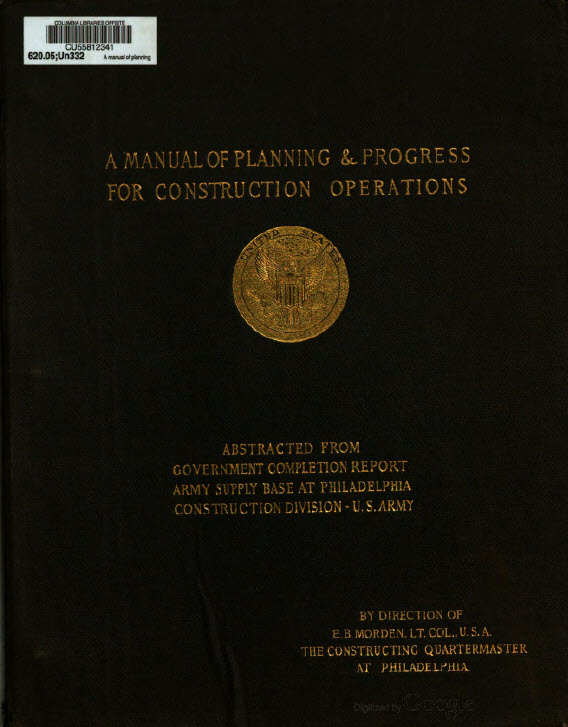 DP: A
Manual for Planning and Progress for Construction
Operations (1920). The contents of this manual
were abstracted from the official completion report of the
Army Supply Base at Philadelphia, 1918 - 1919. The manual
describes the administrative charts and procedures used to
plan and control the construction works for this massive
project.
DP: A
Manual for Planning and Progress for Construction
Operations (1920). The contents of this manual
were abstracted from the official completion report of the
Army Supply Base at Philadelphia, 1918 - 1919. The manual
describes the administrative charts and procedures used to
plan and control the construction works for this massive
project.
Click
through to our page focused on modern
construction management.
Blg: The Diolkos: Innovation, Evolution, or a Parallel Development?. This post looks at a likely precursor to the Dilkos, the Mirgissa slipway constructed in Egypt during the Middle Kingdom period some 1000 years earlier. The Egyptian Forts and the slipway bypassing the Second Cataract were impressive structures.
Blg: The Diolkos – The first truly commercial project? Diolkos on the Isthmus of Corinth in Greece, is probably the first purpose-built railway in the world (if you define a railway as a set of tracks that guide wheeled vehicles). This blog takes a close look at this fascinating project constructed in the early part of the 6th century BCE to transport ship across the isthmus from the Gulf of Corinth to the Saronic Gulf and the port of Athens.
Blg: Shining the light towards low-carbon construction. Two of the world’s longest serving lighthouses are closely related. The original lighthouse was the Pharos of Alexandria. This lighthouse was constructed in the third century BCE and operated for 17 centuries. The second is the ‘Tower of Hercules’, the oldest known working lighthouse, built in the 1st century CE. The longevity of both of these structures are a testament to the durability of a well-constructed stone structure. In an age where minimizing the embedded carbon in buildings is becoming increasingly important, should we be shifting back to durable stone in preference to concrete?
Blg:
Built to last. This post looks at the
durability of Roman road and marine construction
techniques.
Art: The First Dry Docks Dry docks are another class of engineering, similar to canals, that have a remarkably long history. The first modern dry dock (with a gate) was built in 1495 during the reign of Henry VII to dismantle a warship, and use the parts to build another. But, the use of enclosures and other devices to access the bottom of ships goes back to the Egyptians and Phoneticians.
Blg:
The Port of Melbourne is not what it seems.
The Port of Melbourne is the largest port for
containerized and general cargo in Australia. This post
looks at the massive changes made by Victorian engineers
to the Yarra River needed to build this facility.
Blg: The evolution of South Melbourne. We have lived and worked in modern-day South Melbourne for the last 25+ years, so I thought it was time to focus on history closer to home using images of maps I’ve found over the years that show the development of our suburb during its relatively short existence.
 The History of South Melbourne
by Charles Daley, published in 1940 provides a very
detailed history of what was then the City of South
Melbourne from its foundation to the pre-war period: "Where
a century ago there was a primitive wilderness of scrub,
sand, marsh and swamps, surrounding the eminence of a
green hill, and later a cattle run in its rough bush
pastures, there is to-day a populous and flourishing
city, a hive of human enterprise and industry, where
there exists a fine sense of civic pride, which has
fostered all those institutions pertaining to the moral,
physical and intellectual welfare of a civilized
community." Post war the city was amalgamated with a
number of other suburbs to become the City of Pot Phillip.
The book is sourced from: https://www.stkildahistory.org.au/ebooks/Daley.pdf
The History of South Melbourne
by Charles Daley, published in 1940 provides a very
detailed history of what was then the City of South
Melbourne from its foundation to the pre-war period: "Where
a century ago there was a primitive wilderness of scrub,
sand, marsh and swamps, surrounding the eminence of a
green hill, and later a cattle run in its rough bush
pastures, there is to-day a populous and flourishing
city, a hive of human enterprise and industry, where
there exists a fine sense of civic pride, which has
fostered all those institutions pertaining to the moral,
physical and intellectual welfare of a civilized
community." Post war the city was amalgamated with a
number of other suburbs to become the City of Pot Phillip.
The book is sourced from: https://www.stkildahistory.org.au/ebooks/Daley.pdf
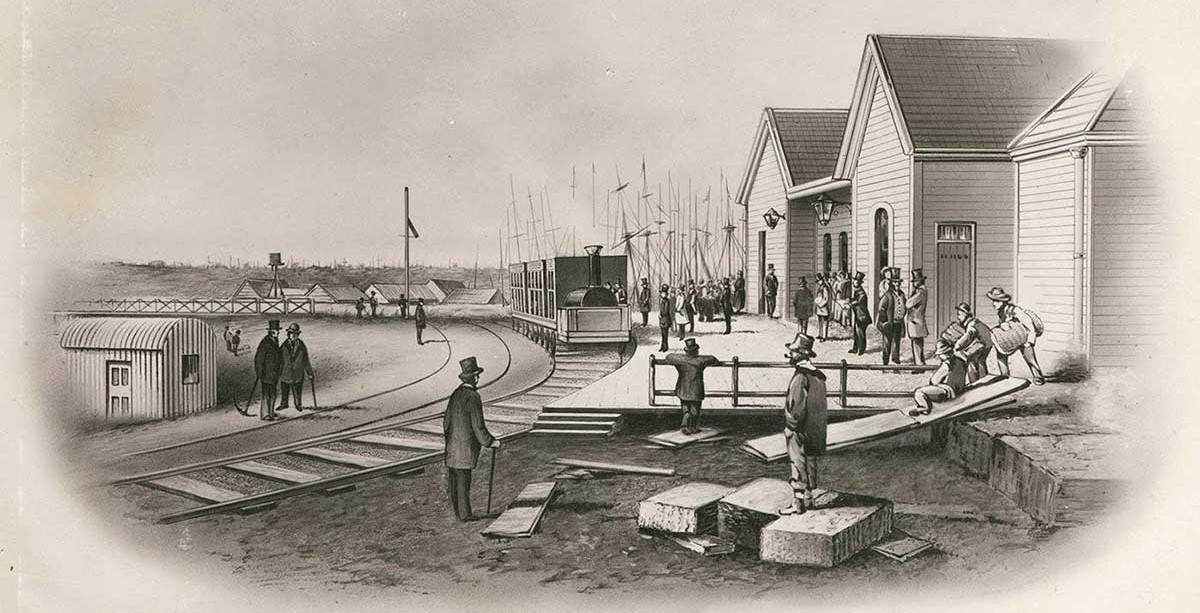 Art:
The First Steam Powered Railway in Australia
Following the discovery of gold in Victoria in 1849, and
the gold rush of 1852/53, the need for an efficient
transport link between the port at Sandridge in South
Melbourne, and the city of Melbourne was paramount. The
problem was overcome by constructing a privately funded
railway that opened in 1854. Other railways soon followed:
See
the detailed 1864 map of Melbourne by H.L. Cox R.N.
Art:
The First Steam Powered Railway in Australia
Following the discovery of gold in Victoria in 1849, and
the gold rush of 1852/53, the need for an efficient
transport link between the port at Sandridge in South
Melbourne, and the city of Melbourne was paramount. The
problem was overcome by constructing a privately funded
railway that opened in 1854. Other railways soon followed:
See
the detailed 1864 map of Melbourne by H.L. Cox R.N.
See also What a difference a few tons of gold
make.
Blg: Is Fishermans Bend heading for the same public transport disaster as Docklands?. The evolution of South Melbourne continues with the previously industrial area of Fishermans Bend being redeveloped into a new suburb with a mix of commercial and residential developments. But good transport planning seems to be missing.
Blg: Getting Big Things Done – was it the gold or the drive? The drive and energy exhibited in developing Melbourne seems to be missing in modern society. This blog looks at some of the achievements in the first 19 years of the city's existence through to the Exhibition of Melbourne in 1854.
Blg: The Port of Melbourne is not what it seems. The Port of Melbourne is the largest port for containerized and general cargo in Australia. This post looks at the massive changes made by Victorian engineers to the Yarra River needed to build this facility.